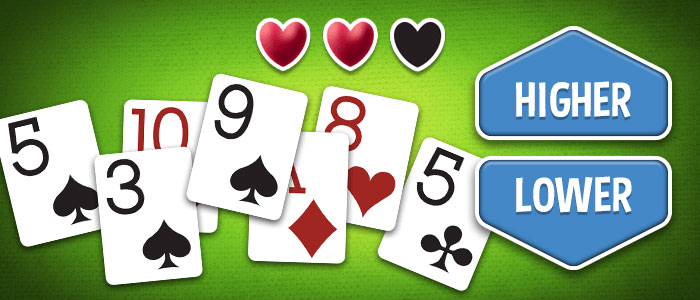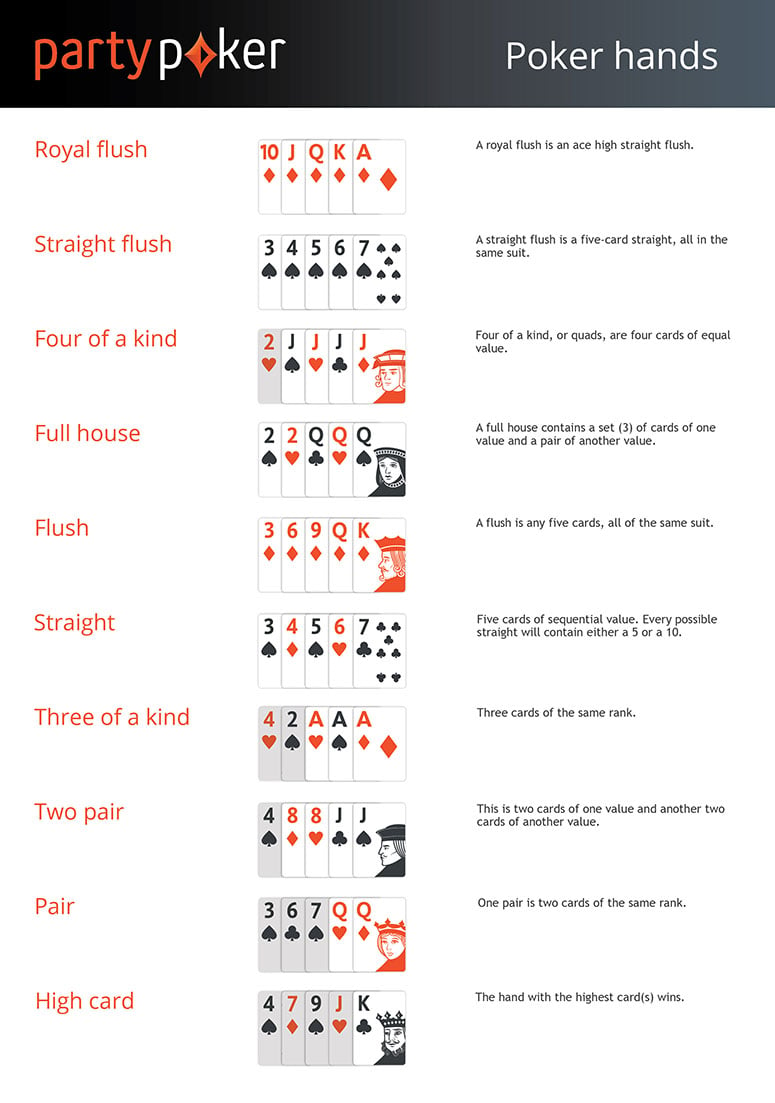Card Hand Rankings
1. Straight Flush
Three cards in sequence of the same suit.An Ace can count as either high or low - e.g. A-K-Q or 3-2-A
Ties are broken by the highest ranked card in the hand except 3 is used for a 3, 2, Ace straight flush.
2. Three of a Kind
Three cards of the same rank.Ties are broken by the rank of the three cards.
3. Straight
Three cards in sequence.Ties are broken by the highest ranked card in the hand except 3 is used for a 3, 2, Ace straight.
4. Flush
Three cards of the same suit.Ties are broken by rank of the highest card, if still tied by the rank of the second highest card and if still tied by rank of the third highest card.
5. Pair
Two cards of the same rank and a third card of different rank.Ties are broken by rank of the paired cards and if still tied by rank of the unpaired card.
6. Nothing
Three cards of different rank and suit, not in sequence - i.e. not any of the above ranked hands.Ties are broken by rank of the highest card, if still tied by the rank of the second highest card and if still tied by rank of the third highest card.
BONUS: Mini Royal
The highest straight flush: A-K-Q all of the same suit.The is the best possible hand you can get in standard five-card Poker is called a royal. This ranking is applicable when the poker table is full ring (9-10 people). The ranking is based on computer calculation results with all the players staying to the river card. It is not applicable to any real play. If the hand is named XXs then it means the hand is suited, if XXo then the hand is off suit. The '+' indicates that all of the hands that rank above that stated hand are included. For example, '55+' includes a pair of fives, and any pair that ranks higher than that, all the way up to a.
Standard Poker Hand Ranking There are 52 cards in the pack, and the ranking of the individual cards, from high to low, is ace, king, queen, jack, 10, 9, 8, 7, 6, 5, 4, 3, 2.
POKER PROBABILITIES

- Texas Hold'em Poker
Texas Hold'em Poker probabilities - Omaha Poker
Omaha Poker probabilities - 5 Card Poker
5 Card Poker probabilities
POKER CALCULATOR
- Poker calculator
Poker odds calculator
POKER INFORMATION
- Poker hand rankings
Ranking of poker hands

In poker, the probability of each type of 5-card hand can be computed by calculating the proportion of hands of that type among all possible hands.
Frequency of 5-card poker hands
The following enumerates the (absolute) frequency of each hand, given all combinations of 5 cards randomly drawn from a full deck of 52 without replacement. Wild cards are not considered. The probability of drawing a given hand is calculated by dividing the number of ways of drawing the hand by the total number of 5-card hands (the sample space, five-card hands). The odds are defined as the ratio (1/p) - 1 : 1, where p is the probability. Note that the cumulative column contains the probability of being dealt that hand or any of the hands ranked higher than it. (The frequencies given are exact; the probabilities and odds are approximate.)
The nCr function on most scientific calculators can be used to calculate hand frequencies; entering nCr with 52 and 5, for example, yields as above.
| Hand | Frequency | Approx. Probability | Approx. Cumulative | Approx. Odds | Mathematical expression of absolute frequency |
|---|---|---|---|---|---|
| Royal flush | 4 | 0.000154% | 0.000154% | 649,739 : 1 | |
| Straight flush (excluding royal flush) | 36 | 0.00139% | 0.00154% | 72,192.33 : 1 | |
| Four of a kind | 624 | 0.0240% | 0.0256% | 4,164 : 1 | |
| Full house | 3,744 | 0.144% | 0.170% | 693.2 : 1 | |
| Flush (excluding royal flush and straight flush) | 5,108 | 0.197% | 0.367% | 507.8 : 1 | |
| Straight (excluding royal flush and straight flush) | 10,200 | 0.392% | 0.76% | 253.8 : 1 | |
| Three of a kind | 54,912 | 2.11% | 2.87% | 46.3 : 1 | |
| Two pair | 123,552 | 4.75% | 7.62% | 20.03 : 1 | |
| One pair | 1,098,240 | 42.3% | 49.9% | 1.36 : 1 | |
| No pair / High card | 1,302,540 | 50.1% | 100% | .995 : 1 | |
| Total | 2,598,960 | 100% | 100% | 1 : 1 |
The royal flush is a case of the straight flush. It can be formed 4 ways (one for each suit), giving it a probability of 0.000154% and odds of 649,739 : 1.
When ace-low straights and ace-low straight flushes are not counted, the probabilities of each are reduced: straights and straight flushes each become 9/10 as common as they otherwise would be. The 4 missed straight flushes become flushes and the 1,020 missed straights become no pair.
Card Hand Rankings Poker
Note that since suits have no relative value in poker, two hands can be considered identical if one hand can be transformed into the other by swapping suits. For example, the hand 3♣ 7♣ 8♣ Q♠ A♠ is identical to 3♦ 7♦ 8♦ Q♥ A♥ because replacing all of the clubs in the first hand with diamonds and all of the spades with hearts produces the second hand. So eliminating identical hands that ignore relative suit values, there are only 134,459 distinct hands.
The number of distinct poker hands is even smaller. For example, 3♣ 7♣ 8♣ Q♠ A♠ and 3♦ 7♣ 8♦ Q♥ A♥ are not identical hands when just ignoring suit assignments because one hand has three suits, while the other hand has only two—that difference could affect the relative value of each hand when there are more cards to come. However, even though the hands are not identical from that perspective, they still form equivalent poker hands because each hand is an A-Q-8-7-3 high card hand. There are 7,462 distinct poker hands.
Derivation of frequencies of 5-card poker hands
of the binomial coefficients and their interpretation as the number of ways of choosing elements from a given set. See also: sample space and event (probability theory).
- Straight flush — Each straight flush is uniquely determined by its highest ranking card; and these ranks go from 5 (A-2-3-4-5) up to A (10-J-Q-K-A) in each of the 4 suits. Thus, the total number of straight flushes is:
- Royal straight flush — A royal straight flush is a subset of all straight flushes in which the ace is the highest card (ie 10-J-Q-K-A in any of the four suits). Thus, the total number of royal straight flushes is
- or simply . Note: this means that the total number of non-Royal straight flushes is 36.
- Royal straight flush — A royal straight flush is a subset of all straight flushes in which the ace is the highest card (ie 10-J-Q-K-A in any of the four suits). Thus, the total number of royal straight flushes is
- Four of a kind — Any one of the thirteen ranks can form the four of a kind by selecting all four of the suits in that rank. The final card can have any one of the twelve remaining ranks, and any suit. Thus, the total number of four-of-a-kinds is:
- Full house — The full house comprises a triple (three of a kind) and a pair. The triple can be any one of the thirteen ranks, and consists of three of the four suits. The pair can be any one of the remaining twelve ranks, and consists of two of the four suits. Thus, the total number of full houses is:
- Flush — The flush contains any five of the thirteen ranks, all of which belong to one of the four suits, minus the 40 straight flushes. Thus, the total number of flushes is:
- Straight — The straight consists of any one of the ten possible sequences of five consecutive cards, from 5-4-3-2-A to A-K-Q-J-10. Each of these five cards can have any one of the four suits. Finally, as with the flush, the 40 straight flushes must be excluded, giving:
- Three of a kind — Any of the thirteen ranks can form the three of a kind, which can contain any three of the four suits. The remaining two cards can have any two of the remaining twelve ranks, and each can have any of the four suits. Thus, the total number of three-of-a-kinds is:

5 Card Hand Rankings
- Two pair — The pairs can have any two of the thirteen ranks, and each pair can have two of the four suits. The final card can have any one of the eleven remaining ranks, and any suit. Thus, the total number of two-pairs is:
9 Card Brag Hand Rankings

- Pair — The pair can have any one of the thirteen ranks, and any two of the four suits. The remaining three cards can have any three of the remaining twelve ranks, and each can have any of the four suits. Thus, the total number of pair hands is:
- No pair — A no-pair hand contains five of the thirteen ranks, discounting the ten possible straights, and each card can have any of the four suits, discounting the four possible flushes. Alternatively, a no-pair hand is any hand that does not fall into one of the above categories; that is, any way to choose five out of 52 cards, discounting all of the above hands. Thus, the total number of no-pair hands is:
- Any five card poker hand — The total number of five card hands that can be drawn from a deck of cards is found using a combination selecting five cards, in any order where n refers to the number of items that can be selected and r to the sample size; the '!' is the factorial operator:
This guide is licensed under the GNU Free Documentation License. It uses material from the Wikipedia.

Home > 5 Card Poker probabilities